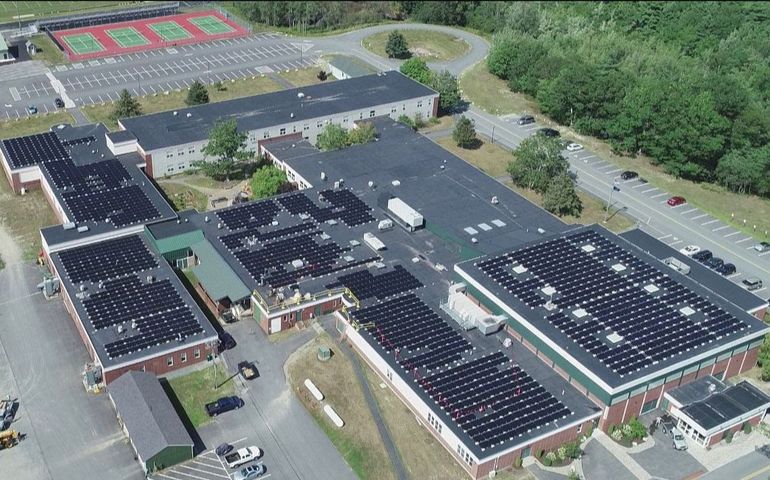Midcoast high school is Maine's first to go 100% solar
 Courtesy / Sundog Solar
Sundog Solar of Searsport installed a 435-kilowatt array of 1,450 panels at Mount Desert Island High School. It’s reportedly the largest high school array in Maine.
Courtesy / Sundog Solar
Sundog Solar of Searsport installed a 435-kilowatt array of 1,450 panels at Mount Desert Island High School. It’s reportedly the largest high school array in Maine.
A recently completed solar installation makes Mount Desert Island High School the first high school in Maine to go 100% solar. The project is also the largest solar array at a Maine secondary school, according to a news release.
The array was installed by Sundog Solar of Searsport, which also recently completed installation of an array at Cranberry Isles Fishermen’s Co-op. The two installations will be celebrated at separate dedications tomorrow, Sept. 18.
The high school will hold a ribbon-cutting ceremony from 12:30 to 1 p.m., in the school's gymnasium.
Cranberry Isles Fishermen's Co-op, on Islesford, will hold a ribbon-cutting event from 4:30-6 p.m., according to A Climate to Thrive’s website. The system of approximately 140 solar panels is expected to save the co-op over $8,000 per year.
100% solar
At MDIHS, the ceremony will include state Speaker of the House Sara Gideon, D-Freeport, and state Rep. Brian Hubbell, D-Bar Harbor. School Superintendent Marc Gousse, Principal Matt Haney, and A Climate to Thrive student interns will also share their thoughts on the installation, sustainability and significance for the school switching to 100% clean electricity. Drone footage of the flat-roof solar array will be presented.
The project was inspired by Drew Rich, class of 2017, whose senior exhibition project served as a catalyst to move the high school to solar energy.
The project was facilitated by A Climate to Thrive, a nonprofit organization committed to energy independence for MDI by 2030. Going solar is expected to save the high school an estimated $1.3 million in electricity costs over 25 years. The high school will remain connected to the grid, generating excess electricity and kilowatt-hour credits in summer to offset lower power output in winter.
"We would not be at this place without a phenomenal partnership comprised of our students, alumni, staff, elected officials, Sundog Solar, A Climate to Thrive and the entire MDI-area community,” Haney said in the release.
The MDIHS Board of Trustees reviewed and approved the solar array in January. Under a power purchase agreement, the high school bears no upfront cost.
Demand picking up
The high school array is Sundog Solar’s largest installation to date, the company’s owner, Chuck Piper, told Mainebiz.
Previously, the firm’s largest project was a 153 kW array installed on a capped landfill in the MDI town of Tremont. The installation was completed in February and is expected to generate 100% of the electricity needed for municipal buildings in the town of 1,600.
Overall, demand is picking up, said Piper.
“We’re starting to book business well into next year,” he said. “We just signed a big project with the town of Oakland. We’ll put solar panels on their landfill next year.”
Projects this year include installation of an array on a Damariscotta landfill, he said.
“We also have a lot of residential work lined up for for this year and into next year,” he said.
Since its founding nine years ago, Sundog Solar has grown from two employees to 28.
“We’ve hired half a dozen people in the last four months and we’re looking for qualified solar installers and electricians,” he added.
Piper attributed the uptick mainly to three renewable energy bills signed by Gov. Janet Mills in June. The new laws establish the Maine Climate Council, charged with developing action plans to reduce Maine greenhouse gas emissions 45% by 2030 and 80% by 2050; increase Maine’s Renewable Portfolio Standard from 40% to 80% by 2030, with a goal of 100% renewable energy by 2050; and create new incentives for energy-efficient heating and solar energy use.
Previously, “Maine was the slowest growing solar state in New England,” said Piper. “But now Maine has solar-friendly laws, so there’s a huge amount of growth that’s going to take place over the next few years. That translates into good-paying jobs.”










0 Comments